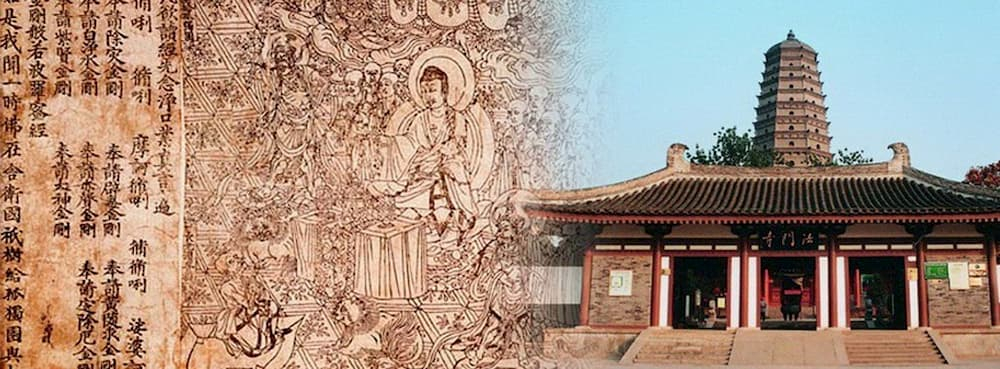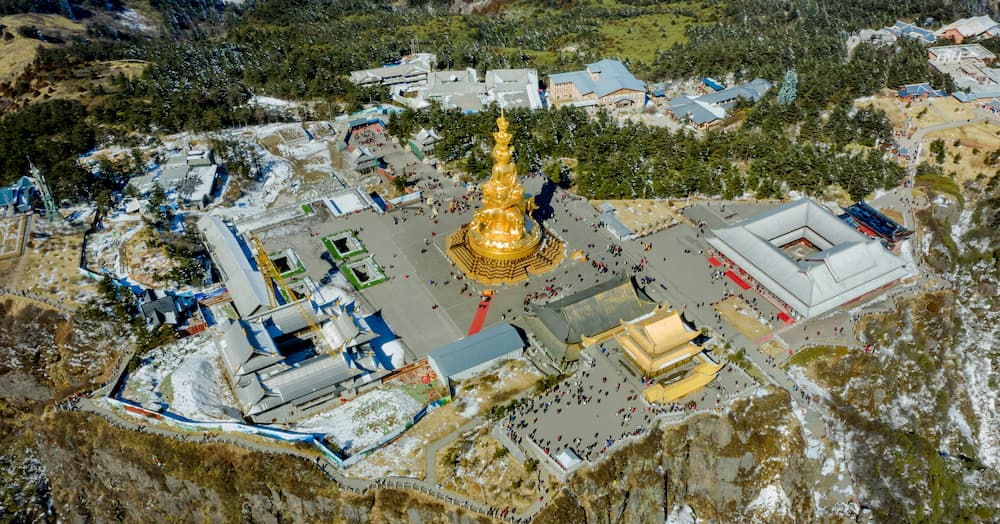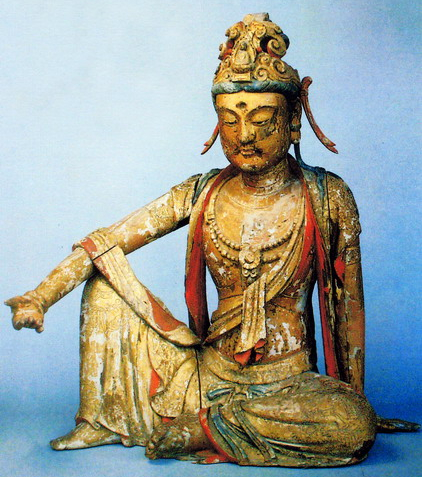
Famen Monastery
Splendid
Chi Culture
Topic
Famen Monastery
The Famen (Dharma Gate) Monastery is located in Famen township, Fufeng county in Baoji city, Shaanxi province. Legend has it that during the Eastern Han dynasty (25–220), a pagoda was built to enshrine the śarīra (cremation relics) of Shakyamuni; the monastery was constructed around this pagoda. From ancient times, the monastery has been illustrious because of the relics enshrined there. The monastery began to develop in the Northern Wei dynasty (386–534), and reached its peak in the Tang dynasty (618–907). It was one of the four sacred Buddhist sites (along with Mount Wutai, Mount Zhongnan, and Puguangwang Monastery in Sizhou), and was revered as an imperial monastery. It covered more than fifteen-hundred mu (about 250 acres) and housed no fewer than ten thousand Buddhist monks. Based on documentation and stele inscriptions, it can be said that the śarīra contains a finger bone that belonged to Shakyamuni. It is regarded as the holiest sacred object in Buddhist world.
The popularity of the Famen Monastery is naturally related to the development of Buddhism, but it also has its own distinctive historical background and development. To sum up, there are several factors that contribute to its importance: 1. The finger bone of Shakyamuni is enshrined in the “True Relic of Buddha Pagoda” in the monastery; 2. The monastery is situated in a place of strategic importance in Western Guanzhong, next to the main ancient “Silk Road” (here also is the road that one had to take to the Renshou Palace of the Sui dynasty (581–618) and the Jiucheng Palace of the Tang dynasty); and 3. The monastery is located at Zhouyuan, the birthplace of the Western Zhou dynasty (ca. 1100–771 BCE).
It was said that Buddhism was introduced to China from India after the reign of King Wu of Zhou (r. 1027–1025 BCE). A poor scholar named Fa Amen from Meiyang village (adjoining Famen Monastery in modern Baoji city, Shaanxi province) was a Buddhist believer. He submitted a petition asking the King of Zhou to promote the religion. However, Buddhism was treated as a heretical belief and the king ordered the arrest of Fa Amen. His legs, hands, and even his tongue, and ears were cut off and his eyes gouged out. Shakyamuni was moved when he heard the story about Fa Amen. He left his will with Emperor Asoka (r. 274–232 BCE) of India saying, “After I die, cut up my body into 84,000 pieces; send one to where Fa Amen lived, and distribute the rest around the world.” After Shakyamuni’s death, Asoka followed the instructions and dispatched a supernatural being to deliver the śarīra to Meiyang village. A ten-zhang (about 33.3 meters) tall pagoda was built at the altar where Fa Amen chanted Buddhist scriptures. At the base of the pagoda was a cave inside which a golden boat sailed on mercury; on this boat was a golden case inside which was the Buddha’s finger bone. The monastery had been named after Asoka, but this was changed to Famen Monastery to commemorate Fa Amen who sacrificed his life for Buddhism. This bit of folklore explains the origin of Famen Monastery, the pagoda, the underground crypt, and the Buddha’s finger bone, as well as the renaming of the monastery. Although it is folklore, the tale has certain value for those studying the monastery.
The Tang dynasty was the golden era of feudal society; it was also the golden age of Buddhism in China. Great importance was attached to Famen Monastery because it housed the Buddha’s śarīra. During the reigns of eight Tang emperors, namely Taizong (626–649), Gaozong (649–683), Wu Zetian (684–705), Zhongzong (684–710), Suzong (756–762), Dezong (780–805), Xianzong (806–820), and Yizong (859–874), the Buddha’s śarīra was received and enshrined in the imperial court six times (the receiving ceremony was performed every thirty years). The reliquaries containing the Buddha’s śarīra, decorated with gold, jade, brocade cloth, and porcelain, were worshiped and offerings were regularly made.
Praying to the Buddha, Emperor Gaozong was the first one who set the precedent to receive and worship the Buddha’s bone in the imperial palace. Before this, the pagoda with the Buddha’s fingerbone was open to the public who frequently venerated it. The Buddha’s śarīra was enshrined at the eastern capital of Luoyang, in an inner palace where Buddhist rites were performed. This was a sign that Buddhism had already made deep inroads within the imperial palace. When the śarīra of the Buddha’s finger was transferred to the palace, Famen Monastery was treated as the inner imperial palace. Thus, the status of Famen Monastery was raised even more during Emperor Gaozong’s reign. The unique features and advantages of the foremost Famen Monastery were increasingly revealed because it enshrined the Buddha’s śarīra.
Eventually, the Famen Monastery began to decline; the situation was exacerbated several times when Buddhism was prohibited. The “Proscription of the Three Wus and the One Zong” was especially adverse for the monastery. Toward the end of the Tang dynasty, the crypt beneath the pogada that had enthrined the Buddha’s śarīra with imperial offerings was sealed. Just like other monasteries in the realm, temple halls were demolished, crypts were destroyed, monks and nuns resumed secular lives, and Buddhist scriptures were burned and lost. Even more serious was the fact that the Buddha’s śarīra was nearly destroyed.







